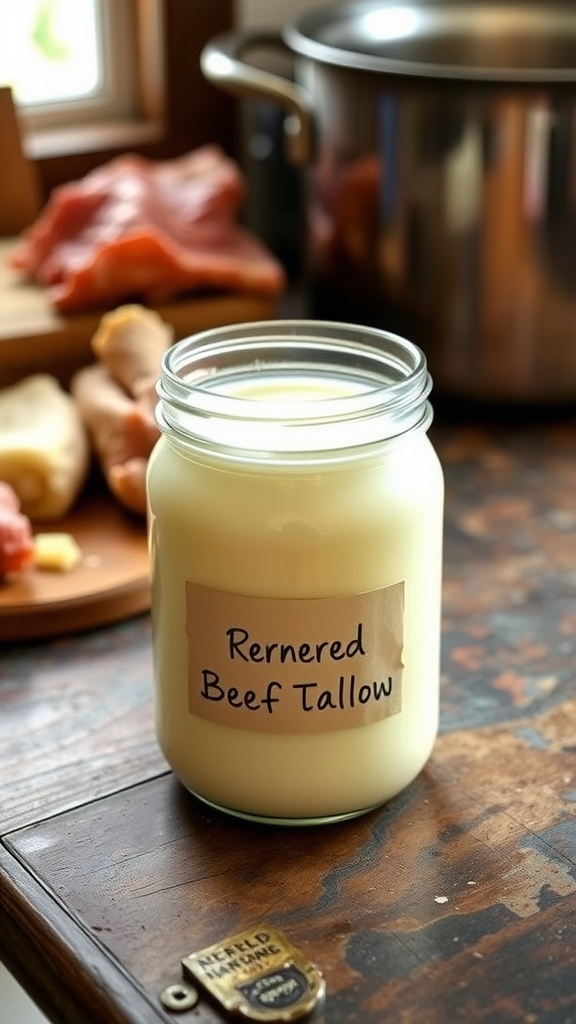If you’ve ever wanted a versatile cooking fat that’s shelf-stable and perfect for frying, baking, or making soap, this guide on rendering beef tallow is for you. Not only is it a great alternative to vegetable oils, but when done correctly, it can be completely odorless and tasteless, making it a fantastic choice for any dish.
Rendering beef tallow might sound intimidating, but it’s actually a straightforward process. With just a few simple steps, you can transform beef fat into a pure, high-quality cooking fat that enhances your recipes without overpowering their flavors. It’s economical, sustainable, and adds a unique richness to your dishes.
Understanding Beef Tallow
Beef tallow is a rendered form of beef fat that has been used for centuries in cooking and food preparation.
It provides a unique flavor and texture that enhances various dishes while offering an alternative to vegetable oils that may not always meet everyone’s preferences.
Rendered beef tallow is not only versatile in culinary applications, but it also boasts a long shelf life, making it an economical choice for home cooks.
With its creamy white appearance, it’s an appealing ingredient to have on hand in the kitchen.
The Rendering Process: An Overview
Rendering beef tallow involves a straightforward method of melting down raw beef fat to separate the liquid fat from solid impurities.
This careful process yields a clean, odorless cooking fat that can be used in a myriad of recipes, from frying to baking, without altering the dish’s original flavors.
During the rendering process, the fat is heated slowly to ensure that it melts evenly.
Keeping a close watch on the temperature is essential, as high heat can lead to unwanted browning or burning, compromising the quality of the tallow.
What You Need to Get Started
To embark on the journey of rendering beef tallow, you’ll need just a few essential ingredients.
Primarily, you will require 2-3 pounds of beef fat, ideally from suet or trim, which can be sourced from local butchers or specialty meat shops.
While water is optional—sometimes added to prevent burning—salt can also be included for preservation purposes.
Having these basics ready will set you up for a successful rendering experience.
Steps to Render Beef Tallow
The first step involves preparing the fat by trimming off any meat or connective tissue.
Cutting the fat into small, uniform pieces is critical for even melting, and if you have a grinder, this can be a handy tool to utilize.
Once prepared, the fat is melted in a large pot or slow cooker over low to medium heat.
As the fat renders, stirring occasionally helps maintain an even temperature and prevents scorching.
Storing Your Rendered Tallow
After the rendering process is complete, the tallow needs to be strained.
Using a fine mesh strainer or cheesecloth will effectively remove any solid bits, leaving you with a smooth liquid.
Allow the rendered tallow to cool at room temperature before transferring it into airtight jars.
Storing it in a cool, dark place ensures a long shelf life, enabling you to enjoy this versatile cooking fat for months to come.
A Step-by-Step Guide to Rendering Odorless Beef Tallow

This method of rendering beef tallow yields a clean, neutral fat that can be used in a variety of culinary applications. The result is a creamy, smooth tallow that can be stored for long periods without refrigeration, making it a staple in traditional cooking.
Ingredients
- 2-3 pounds of beef fat (suet or trim)
- Water (optional, for the pot)
- Salt (optional, for preservation)
Instructions
- Prepare the Fat: Trim off any remaining meat or connective tissue from the beef fat. Cut the fat into small, uniform pieces or grind it to ensure even melting.
- Melt the Fat: In a large pot or slow cooker, add the beef fat. If desired, add a small amount of water to help prevent burning. Heat the fat over low to medium heat until it begins to melt, stirring occasionally.
- Render the Tallow: Allow the fat to cook slowly, stirring occasionally. As it melts, the solids will sink to the bottom. Keep an eye on the temperature and avoid high heat to prevent browning or burning the fat.
- Strain the Liquid: Once the fat has completely melted and the solid bits have turned golden brown, carefully strain the liquid tallow through a fine mesh strainer or cheesecloth into a heatproof container. This removes any impurities.
- Cool and Store: Allow the rendered tallow to cool at room temperature before sealing it in airtight jars or containers. Store in a cool, dark place for long shelf life.
Cook and Prep Times
- Prep Time: 15 minutes
- Cook Time: 2-4 hours
- Total Time: 2 hours 15 minutes to 4 hours 15 minutes
Nutrition Information
- Servings: Varies
- Calories: Approximately 115 calories per tablespoon
- Fat: 13g
- Protein: 0g
- Carbohydrates: 0g
